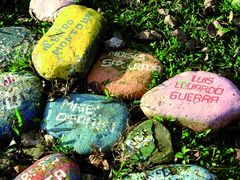Article published in the special Newsletter '15 years of PBI', October 2009
Erika Zarate, volunteer from Canada (2004-5)
PBI volunteers accompany a commission to search for the disappeared when news of the massacre arrives.
At midnight on 22 February 2005 Jesús, a member of the San José de Apartadó Peace Community, made an urgent call to the PBI house in Turbo. He told us that eight members of the community had disappeared, including the leader Luís Eduardo Guerra, and that the community feared for his safety. Jesús asked us for international accompaniment for a commission to search for the disappeared persons.
Robert, a Spanish volunteer with PBI, three other international persons, Elkin (a Colombian lawyer specialising in human rights with the Corporation Judicial Freedom) and I went to the Peace Community in order to accompany one hundred women and men in the search for their friends and family members. As a measure of protection, and also an act of solidarity, the community organised itself to go in large groups.
The commission left at four in the morning on 24 February, heading for the home of Alfonso Bolívar, one of the most active members of the Peace Community. The way was steep and muddy. After seven hours on foot we finally arrived at the farm. Soldiers and police surrounded us and Robert explained to them that we were international workers accompanying a civilian commission and that our team had personally informed the Vice President of Colombia, the General of the XVII Brigade and many embassies and UN bodies of our presence there. The military official in charge told his troops to lower their arms and to let the commission pass.
When we arrived we found ourselves contemplating a horrendous scene: a humble family home with blood splashed all over the entrance to the house, empty cartridges on the ground, and the severed hand of a small girl sticking out from a pile of rotten cacao fruit shells. A painful silence overcame us.
I called the PBI team in Turbo and I gave them the exact location of the farm so that the forensic team of the Office of the Human Rights Ombudsman could find us easily. Its helicopter landed hours later and the authorities and scientists began to work immediately. The forensic process was observed by the Colombian lawyer, several leaders from the community and three international accompaniers.
The investigators found three adults and two small children in a mass grave. The adults displayed torture marks made with a machete. The five had been beheaded. The victims of the massacre were: Alfonso Bolívar; his partner, Sandra Muñoz; their children, Natalia (six) and Santiago (two) and a farm worker, Alejandro Pérez.
When the helicopter arrived to collect the forensic team and the plastic bags that contained the human remains, the commission prepared to continue the search, heading towards the house of Luís Eduardo Guerra and his family. As we were about to leave, it was a painful shock to see the soldiers taking photos in front of the bags that contained the bodies, making signs of victory with their fingers.
After some five more hours walking, and without any sign of the disappeared persons, we decided to camp on an abandoned farm until the following morning. I was at the front of the commission that day. After following the river for a long time I stumbled across the skull of Deiner, a playful but timid boy of ten with whom I had shared sweets and free time on previous occasions. We all continued up river in a state of numbness until we found the bodies of Luis Eduardo Guerra and his partner Beyanira Guzmán, and the remains of their son Deiner.
Whilst we waited for the forensic team, we took turns scaring away the crows and hogs that tried to eat the corpses. We waited until nightfall, but when we realised that nobody from the team of the Office of the Human rights Ombudsman was going to arrive, one part of the commission, accompanied by us, returned to San José de Apartadó. We left behind a group of 25 members of the community and the human rights lawyer to guard the last victims of the massacre.
The return to Turbo was dizzying. PBI had mobilised an urgent action and members of all the teams were busy sending emails, making telephone calls and meeting with any actor who had a role or responsibility in resolving the massacre. PBI sent me to Bogotá to meet dozens of UN representatives, various embassies and high level civilian authorities, in order to promote the protection of the peace community and to demand a transparent investigation into the massacre.
Five years later we continue to accompany the leaders of the San José de Apartadó Peace Community, a pioneer and model community, who continue to defend their principles of non-violence, justice, solidarity, freedom, dialogue and respect.
Demanding comprehensive justice
The case of the massacre of 21 February 2005 had much repercussion in the international community because of the cruelty of the acts and the fact that there were child victims. Initially the Government stated that the FARC were responsible for the massacre 1. However, since 2007 several soldiers from the XVII Brigade have been investigated 2 and the trial of eight of them began that year. They were charged with the homicide of protected persons, acts of barbarity and arrangement to commit an offence 3. Similarly, in 2008 a Captain accepted a plea bargain, recognising his responsibility in the acts 4. These military officials had supposedly been acting together with paramilitaries5. It is worth highlighting the broader context of the number of aggressions against the Community since its creation in 1997: more than 165 cases of assassination and forced disappearance and almost 600 cases of reported human rights violations 6.
Another three coordinators have been assassinated since the massacre occurred7.Most of the crimes continue to go unpunished. The Peace Community benefits from provisional measures, ordered by the Inter American Court of Human Rights, which urge the Colombian State to order «immediate measures necessary for the effective protection of the lives and personal integrity of all the members of the San José de Apartadó Peace Community»8.
--
1 «La comunidad tenía razón», El Tiempo newspaper, 24 July 2007
«Audiencia de juzgamiento a militares será en diciembre, niegan nulidad de juicio por masacre en Comunidad de Paz», El Tiempo, 26 August 2009
2 «Verdades de la masacre de San José de Apartadó», El Espectador newspaper, 2 August 2008
«Por homicidio en persona protegida y terrorismo, a indagatoria 56 Militares», El Tiempo, 22 February 2007
3 «Audiencia de juzgamiento a militares será en diciembre, niegan nulidad de juicio por masacre en Comunidad de Paz», El Tiempo, 26 August 2009
4 «Capitán (r) del Ejército aceptó su responsabilidad por masacre de San José de Apartadó», El Tiempo, 1 August 2008
5 «Verdades de la masacre de San José de Apartadó», El Espectador, 2 August 2008
«Audiencia de juzgamiento a militares será en diciembre, niegan nulidad de juicio por masacre en Comunidad de Paz», El Tiempo, 26 August 2009
6 «La Historia vivida», San José de Apartadó Peace Community, 21 December 2006
7 «Paramilitares asesinan a Dairo», San José de Apartadó Peace Community, 15 July 2008
«Cronología de agresiones contra la Comunidad de Paz de San José de Apartadó y población de la zona, con posterioridad al 7 de agosto de 2002», San José de Apartadó Peace Community, 31 January 2008
8 «Medidas provisionales respecto a Colombia, asunto de la comunidad de paz de San José de Apartadó», Resolution of the Inter American Court of Human Rights, 6 February 2008

